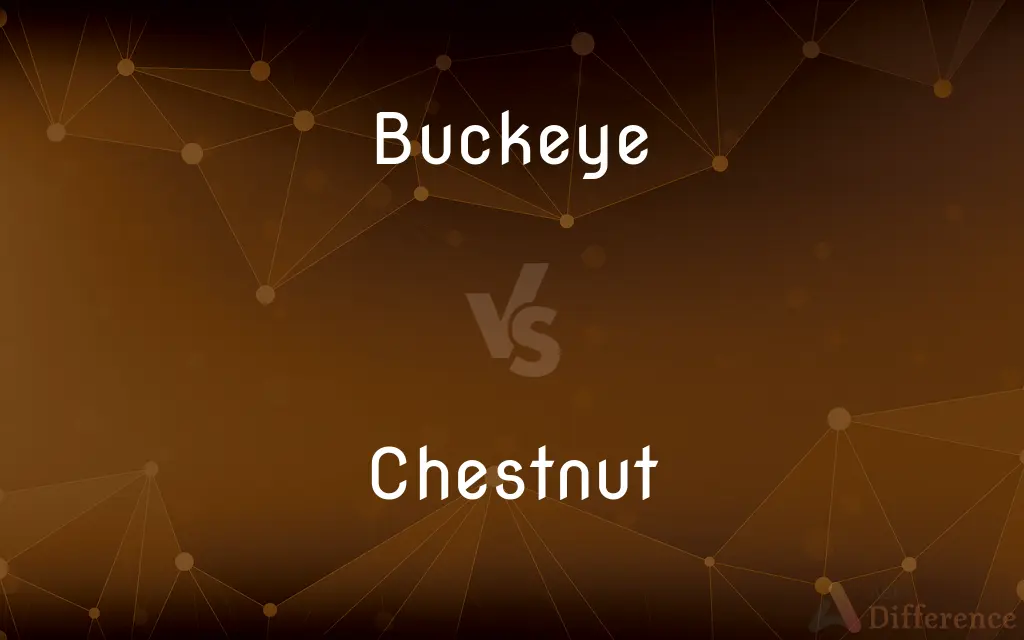Buckeye vs. Chestnut — What's the Difference?
By Tayyaba Rehman — Updated on June 8, 2024
A Buckeye is a tree or shrub in the genus Aesculus, producing inedible seeds; a Chestnut is a tree in the genus Castanea, producing edible nuts.

Difference Between Buckeye and Chestnut
Table of Contents
ADVERTISEMENT
Key Differences
Buckeye and Chestnut are terms that often refer to trees and their respective seeds or nuts. Buckeyes are primarily associated with trees or shrubs in the genus Aesculus. These trees produce seeds that are inedible and can even be toxic. They are characterized by their shiny appearance and a distinct "eye" marking, which gives them their name. Chestnuts, on the other hand, are from trees belonging to the genus Castanea. These trees yield nuts that are edible and are often used in culinary dishes around the world.
While both Buckeye and Chestnut trees bear similar-looking seeds/nuts, they have clear differences. Buckeye seeds are larger and feature a prominent, glossy brown seed with a paler "eye" spot. Chestnuts, in contrast, are encased in a spiky burr and, when removed, reveal a nut that's both edible and tasty.
It's important to note that while Chestnut trees produce nuts cherished in various cuisines, consuming a Buckeye seed can be harmful. Mistaking a Buckeye for a Chestnut and eating it may result in sickness. Therefore, it's vital to distinguish between the two, especially when foraging.
Culturally, the term "Buckeye" has significance in the U.S., particularly in Ohio, which is known as the "Buckeye State." The tree is symbolic to Ohioans. Chestnut trees, meanwhile, have had both cultural and economic importance in various regions, especially in parts of Europe and Asia, where the nuts are celebrated and incorporated into numerous dishes.
Comparison Chart
Genus
Aesculus
Castanea
ADVERTISEMENT
Edibility
Inedible and can be toxic
Edible and used in various dishes
Appearance
Glossy brown seed with a paler "eye" spot
Nut encased in a spiky burr
Symbolism
Symbolic in Ohio, USA
Cultural and economic importance in parts of Europe and Asia
Use
Mostly ornamental or symbolic
Culinary and wood production
Compare with Definitions
Buckeye
A nickname for someone from Ohio, USA.
As a Buckeye, he takes pride in his Ohioan heritage.
Chestnut
A deciduous tree belonging to the genus Castanea.
Chestnut trees shed their leaves in the fall.
Buckeye
A tree or shrub belonging to the genus Aesculus.
The Buckeye tree's seeds have a distinctive eye marking.
Chestnut
The chestnuts are a group of eight or nine species of deciduous trees and shrubs in the genus Castanea, in the beech family Fagaceae. They are native to temperate regions of the Northern Hemisphere.
Buckeye
The inedible, potentially toxic seed of such trees.
It's crucial not to confuse a Buckeye with an edible nut.
Chestnut
A glossy hard brown edible nut which develops within a bristly case and which may be roasted and eaten.
Buckeye
Any of various American butterflies, having eyespots on the wings.
I spotted a beautiful Buckeye butterfly in the garden today.
Chestnut
The large European tree that produces the edible chestnut, with serrated leaves and heavy timber.
Buckeye
A symbol or emblem related to the state of Ohio.
The Buckeye is an iconic symbol of Ohio State University.
Chestnut
A small horny patch on the inside of each of a horse's legs.
Buckeye
An American tree or shrub related to the horse chestnut, with showy red or white flowers.
Chestnut
Any of several deciduous trees of the genus Castanea native to northern temperate regions, having alternate simple toothed leaves, and nuts that are enclosed in a prickly husk.
Buckeye
An orange and brown New World butterfly with conspicuous eyespots on the wings.
Chestnut
The often edible nut of any of these trees.
Buckeye
A native of the state of Ohio.
Chestnut
The wood of any of these trees.
Buckeye
A kind of automatic coupling for railway rolling stock.
Chestnut
Any of several other plants, such as the horse chestnut.
Buckeye
Any of several North American trees or shrubs of the genus Aesculus, having palmately compound leaves, erect panicles of white, yellow, or red flowers, and a leathery capsule containing one or more large seeds. All parts of the plant are poisonous.
Chestnut
A moderate to deep reddish brown.
Buckeye
The large shiny brown seed of any of these plants.
Chestnut
A reddish-brown horse.
Buckeye
A nymphalid butterfly (Junonia coenia) of North America, having brownish wings with orange markings and conspicuous eyespots.
Chestnut
A small hard callus on the inner surface of a horse's foreleg.
Buckeye
Buckeye A native or resident of Ohio.
Chestnut
An old, frequently repeated joke, story, or song.
Buckeye
Any of several species of trees of the genus Aesculus.
Chestnut
Of a moderate to deep reddish brown.
Buckeye
Aesculus hippocastanum, the horse chestnut.
Chestnut
A tree or shrub of the genus Castanea.
Buckeye
Any of several species of the related Mexican buckeye (genus Ungnadia).
Chestnut
A nut of this tree or shrub.
Buckeye
The seed or fruit of these plants.
Chestnut
(uncountable) A dark, reddish-brown colour, as seen on the fruit of the chestnut tree.
Buckeye
A native or resident of the American state of Ohio.
Chestnut
A reddish-brown horse.
Buckeye
The Junonia coenia butterfly.
Chestnut
(uncountable) The wood of a chestnut tree.
Buckeye
(US) A confection made from peanut butter fudge partially dipped in chocolate to leave a circle of peanut butter visible, supposed to resemble the nut of the Ohio buckeye tree.
Chestnut
(figurative) An old joke; a worn-out meme, phrase, ploy, etc. so often repeated as to have grown tiresome or ineffective (often in the phrase "old chestnut").
Buckeye
A name given to several American trees and shrubs of the same genus (Æsculus) as the horse chestnut.
Chestnut
A round or oval horny plate found on the inner side of the leg of a horse or other animal, similar to a birthmark on a human.
Night eye
Buckeye
A cant name for a native or resident of Ohio.
Chestnut
(UK) The horse-chestnut.
Buckeye
The inedible nutlike seed of the horse chestnut
Chestnut
Of a deep reddish-brown colour, like that of a chestnut.
Buckeye
Tree having palmate leaves and large clusters of white to red flowers followed by brown shiny inedible seeds
Chestnut
The edible nut of a forest tree (Castanea vesce) of Europe and America. Commonly two or more of the nuts grow in a prickly bur.
Buckeye
A resident of Ohio
Chestnut
The tree itself, or its light, coarse-grained timber, used for ornamental work, furniture, etc.
Chestnut
A bright brown color, like that of the nut.
Chestnut
The horse chestnut (often so used in England).
Chestnut
One of the round, or oval, horny plates on the inner sides of the legs of the horse, and allied animals.
Chestnut
An old joke or story.
Chestnut
Of or pertaining of a chestnut; of a reddish brown color; as, chestnut curls.
Chestnut
Wood of any of various chestnut trees of the genus Castanea
Chestnut
Any of several attractive deciduous trees yellow-brown in autumn; yield a hard wood and edible nuts in a prickly bur
Chestnut
Edible nut of any of various chestnut trees of the genus Castanea
Chestnut
A small horny callus on the inner surface of a horse's leg
Chestnut
A dark golden-brown or reddish-brown horse
Chestnut
Used of hair; of a golden brown to reddish brown color;
A chestnut horse
Chestnut hair
Chestnut
The edible nut of such a tree.
Roasted chestnuts are a holiday treat in many cultures.
Chestnut
A reddish-brown color resembling the nut.
She colored her hair a deep chestnut shade.
Chestnut
A type of horse with a reddish-brown coat.
The chestnut horse stood out among the others.
Chestnut
An old or stale joke or story.
That joke is an old chestnut; I've heard it before.
Common Curiosities
Why is Ohio known as the "Buckeye State"?
The state has an abundance of Buckeye trees, making it symbolic for Ohioans.
Can you identify a Buckeye by its appearance?
Yes, Buckeyes have a glossy brown seed with a paler "eye" spot.
How can I distinguish between a Buckeye and a Chestnut?
Buckeyes have a distinct "eye" marking, while Chestnuts are encased in a spiky burr.
What is the primary difference between a Buckeye and a Chestnut tree?
A Buckeye belongs to the genus Aesculus and has inedible seeds, while a Chestnut belongs to the genus Castanea and produces edible nuts.
Are Buckeye seeds safe to eat?
No, Buckeye seeds are inedible and can be toxic if consumed.
What's the significance of Chestnut trees in Europe?
Chestnuts have cultural and culinary importance, especially in parts of Europe where they are used in various dishes.
How has the Chestnut tree's role changed in the U.S. over time?
The American Chestnut was once widespread but has drastically decreased due to the Chestnut blight in the 20th century.
How are Chestnuts typically consumed?
Chestnuts can be roasted, boiled, or used in various dishes.
Are Chestnuts and Horse Chestnuts the same?
No, Horse Chestnuts are related to Buckeyes and are not safe to eat, while Chestnuts are edible.
Is the Buckeye tree native to the U.S.?
Yes, several Buckeye species are native to various parts of the U.S.
Why should one be cautious with Buckeyes?
Consuming Buckeye seeds can be harmful, leading to sickness.
Are Chestnuts used for anything besides food?
Yes, Chestnut wood is used for furniture and other items due to its durability.
How does the Buckeye tree contribute to ecosystems?
Buckeye trees provide habitat and food for various wildlife, despite their seeds being inedible for humans.
Is the term "chestnut" used in any other context?
Yes, "chestnut" can refer to a horse's reddish-brown coat or an old, repeated joke or story.
What are the culinary uses of Chestnuts?
Chestnuts can be roasted, turned into flour, or used in dishes like soups and desserts.
Share Your Discovery

Previous Comparison
Bundle vs. Bindle
Next Comparison
Dummy vs. MannequinAuthor Spotlight
Written by
Tayyaba RehmanTayyaba Rehman is a distinguished writer, currently serving as a primary contributor to askdifference.com. As a researcher in semantics and etymology, Tayyaba's passion for the complexity of languages and their distinctions has found a perfect home on the platform. Tayyaba delves into the intricacies of language, distinguishing between commonly confused words and phrases, thereby providing clarity for readers worldwide.
















































